A comparison of bikeway spending and resulting bike use shows that Portland is way behind in opening up its pocketbook to pedaling.
Along with the rising profile of bike boxes, bike boulevards, bike trails, and bikes in general in Portland will come an increased scrutiny on how that infrastructure is paid for. Skeptics (or just plain enemies) of the non-motorized transportation revolution are sure to use the financial question as a way to try and stop the rising tide of bike spending and encouragement in Portland.
“Bicycling has been a very cheap date.”
–City of Portland bike coordinator Roger Geller
But regardless of naysayers, the fact is nearly every major bureaucrat and politician in Portland, and a majority of people that live here (an assumption, I admit) want to see increased bike use (or at least wouldn’t admit publicly otherwise).
Even Portland’s official Comprehensive Plan, which is intended to “guide the future growth and development of the city,” states (in section TRN-6.01) one of our goals is to:
“Make the bicycle an integral part of daily life in Portland, particularly for trips of less than five miles, by implementing a bikeway network, providing end-of-trip facilities, improving bicycle/transit integration, encouraging bicycle use, and making bicycling safer.”
It doesn’t take an activist to realize that bikes are a clean, cheap, and readily available solution to a host of major problems facing not just Portland and the rest of America, but the entire planet as well.
So, if we truly want to increase the amount of people who go by bike — and adequately and safely serve those who already do — we can’t be afraid to put our money where our mouths are.
- 28: Percentage of SE Portland residents
who use their bike as a primary
or secondary commute vehicle. - 16: Percentage of Portlanders citywide
who use their bike as a primary or
secondary commute vehicle. - 6: Percentage of Portlanders citywide
who regularly bike to work. - 0.7: Percentage of PDOT’s capital
budget spent on bicycle infrastructure. - $37.00: Amount spent per capita/per year
on bikes in Amsterdam - $1.28: Amount spent per capita/per year
on bikes in Portland.
A recent survey by the City Auditor showed that citywide, 16% of Portlanders use a bike as either their primary or secondary commute vehicle. In Northeast and Southeast Portland that number jumps up to 22% and 28% respectively.
However, despite these numbers (and all the other benefits biking brings to our city), the faucet is still barely at a trickle.
Let’s review: 16% of Portlanders rides bikes as transportation at least occasionally (and 6% do so regularly), yet we get less than 1% of PDOT’s capital infrastructure budget. And, when we do line up for new funding streams (like Commissioner Adams’ Safe and Sound Streets initiative), our piece becomes the center of media attention, partisan politics, and we’re forced to justify our tiny piece of the pie (which in the case above was a mere $24 million out of $450 million).
Yet, even with this paltry piece of the spending pie, Portland has built a bike network and culture envied around the world and it is clearly the most bike-centric metropolis in America. The take-away from that: Bikes are the best transportation investment money can buy. Or, as PDOT’s bike coordinator Roger Geller likes to put it, “bicycling is a very cheap date”.
Just imagine what will happen once we begin to invest in our bike infrastructure like we should.
For a glimpse at what’s possible, check out the graph below. It compares the annual per capita bikeway spending of Portland with four European cities alongside the percentage of people that use bikes to get around. On one end of the spectrum is Portland with less than $2.00 per capita going to bikes and on the other is Amsterdam, with close to $40.00 being spent per capita…
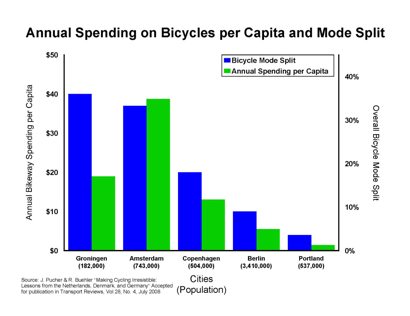
(Click to enlarge)
The data comes from Rutgers University “bicycling scholar” John Pucher and it was recently used as part of a presentation at the National Bike Summit by PDOT bicycle coordinator Roger Geller.
Geller has been leading the charge at PDOT with his mantra of wanting to build a “world class bike city in an American context,” but even PDOT’s proposed capital funding for the next four years doesn’t look too great for bikeway spending (that little green line at the very left is for bikes and the three bars at the right are for motor vehicles):
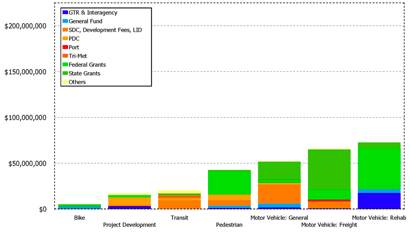
Click to enlarge
So where will the money come from? Luckily, bike planners have evolved (out of necessity) to be very opportunistic predators when it comes to finding money for bike projects. I’m confident in their ability to keep expanding our bike network, but if we really expect them to build us a “world class bike city” in any context, I wish they could spend less time looking for money and more time figuring out where to spend it.


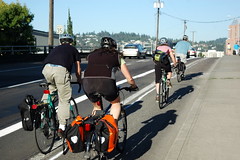
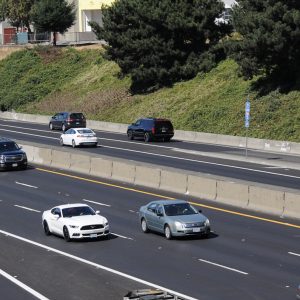
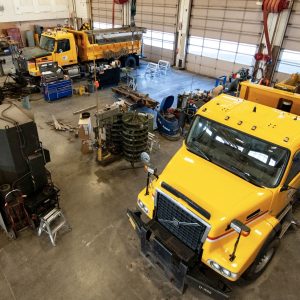
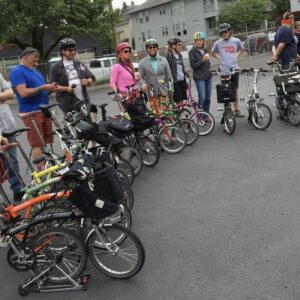
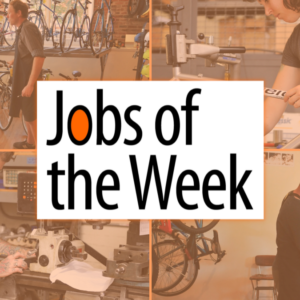
Thanks for reading.
BikePortland has served this community with independent community journalism since 2005. We rely on subscriptions from readers like you to survive. Your financial support is vital in keeping this valuable resource alive and well.
Please subscribe today to strengthen and expand our work.
Jonathan, do you have any details on what percentage of the pedestrian spending is for facilities that are also used by bikes? Would the funding for trails like the Springwater trail be put under bikes or pedestrian? Thanks!
Great message, Jonathan. I wish that other city planners and DOTs could hear and understand it. You may feel as though you\’re scuffling for scraps down there, but up here in Seattle we\’ve become accustomed to nothing but mountains of lip service and battles that last for decades for even minimal results. The do say that this is changing…we\’ll see.
Steven, I am not an expert on funding and once you start looking more closely into the topic it quickly becomes a confusing mess (at least to me)…. there are rarely clear (and short) answers. So to answer your question.. I don\’t know the answer to your question, but stick around for a while and maybe another reader will.
In all fairness, we cyclists benefit from projects that aren\’t \”bicycle-only.\” Smooth streets free of cracks and potholes are a good thing :-).
Similarly, a traffic realignment project that straightens out a dangerous intersection benefits us all, even if only a small percentage of the money spent is on the bike lanes.
Let\’s not forget that I like the fact that delivery trucks can cheaply, safely, and efficiently deliver my bike tires and other goodies to my LBS.
My point here is that adequate funding of cycling as a transportation mode doesn\’t necessarily have to equate exactly with an apparent mode split.
On a slight tangent, when I was at my andwebike.com event on Tuesday, I noticed that only about 3 or 4 percent of the motorized vehicles were actually delivery, business, or service vehicles. If we could stop the fat lazy selfish couch potatoes from using their terrorist-funding climate-warming pedestrian-killing behemoths for three mile trips, the existing investment in infrastructure would be completely sufficient for everyone
[end of rant]
great article… Thanks Jonathan.
Jason-
There are plenty of places (ie lower broadway) that could benefit from some bike-specific money.
It\’s a good point that Jason P. makes.
Jonathan (and others)
I\’m curious whether any of you who work with the politics of bikes in Portland are seeing a phenomenon I\’m a little paranoid about. Since we ARE looked to by the rest of the country and the world as a model of what\’s right in incorporating bikes, are those who hold the purse strings reluctant to commit more because of that? What I mean is, are there folks in leadership who are not hostile to cycling, per se, but who simply see our good press as evidence that we have all we need, that everything\’s fine? I\’m curious.
\”are there folks in leadership who are not hostile to cycling, per se, but who simply see our good press as evidence that we have all we need, that everything\’s fine?\”
You mean.. complacency? Heck yes I do think that is an issue with Portland both at a local/city level and at the state/ODOT level.
There is a sense on a statewide level that we already get more than our fair share so now it\’s time to spread things to other communities. But the flipside of that thinking is… why should Portland be punished for success?
I know that sometimes PDOT and others have to work extra hard to get money from ODOT to combat this perception…
on a local level, I think complacency was the reason why PDOT disbanded their Bike Program. There used to be an entire division in PDOT for bike planning and implementation… it was funded to the tune of about $1 million per year and was responsible for the fast growth in our bikeway in the mid-late \’90s.
But, PDOT dismantled the program and claimed it was because bike-friendly ideas had successfully permeated into all the other bureaus.
but now i think there might be an effort to rebuild the bike program… but I\’m not sure about that.
I think given the continued growth of biking in Portland, PDOT should absolutely have more staff resources specifically allocated to accommodating bike traffic.
Great Blog entry! Excellent points including those in #8 and #9.
I\’m glad one of the 4 European cities in the graph titled \”Annual Spending on Bicycles per Capita and the Resulting Mode Split\” was Berlin.
Berlin made a conscious decision to invest in bike facilities after the reunification of the city because it was cheap and gave the most \”bang for the buck\” (or Euro) compared to any other transportation option.
Oh yeah duhh…
I should have also said that Berlin was broke and didn\’t have the money to rebuild the transportation system in the eastern half of the city up to western standards. There were (and still are) so many other things that Berlin needed to spend its limited resources on.
So they kept the old street cars in the eastern half instead of replacing them with VERY expensive \”U-bahns\” (subways). For the cost of building 1 mile of new U-bahn they could build the bicycle network many, many times over. Like I said before, Berlin decided to invest heavily in cycling and cycling mode share rose significantly. Bicycling would probably be even more popular in Berlin if the city wasn\’t so spread out (Too many parks a green spaces spread through out the city).
It should be noted that Berlin is flatter than a pancake. Wish I\’d had a bike with me when I was there every so often for work.
Thanks, Jonathan for yet another great piece of journalism!
I would only add (and I know I\’ve said this before) that according to the 2000 Census here in Portland approximately 18% of households DO NOT OWN A CAR. Eighteen Percent! There are census tracts in Portland where this figure jumps to 30, 40 or even 50%, and in some of the downtown census tracts the figure is 80-90%. Eighteen percent is one is close to one in five households.
Whether or not these folks use a bike to commute, they are most likely not taking advantage of the car infrastructure we all pay for to the degree some of these statistics might imply. Yes, there is surely overlap–and the smooth pavement helps me get to the Hawthorne bridge a little faster than gravel would–but the wear on the road infrastructure from bike and pedestrian traffic is tiddly winks compared to those studded tires that have lately become so fashionable.
Reuben Deumling
I realize there are funding equity issues here, but PDOT also has information that clearly shows that the number of cyclists has increased substantially in recent years despite the lack of investment in new bicycle infrastructure.
Jonathan #9. Why is it you assert in your article that the majority of Portlanders are, \”…behind the bicycle revolution…\”, but then clearly contradict this opinion by going on to say in your comment that you see complacency at all levels of government, and the community, et al, regarding bike use, and infrastructure?
Which is it? Do the one-thousand or so cyclists making such loud noises represent everyone on a bicycle or not?
Sure wish you\’all could make up your minds.
Question. If Amsterdam is so great, what\’s keeping you from moving there, instead of disrupting the lives of native Oregonians who cycle?
To BURR #14:
Not true that we haven\’t invested in infrastructure. We have. What we haven\’t done a lot of in recent years is substantially extend our bikeway network. What we have done is spend (relatively) big bucks on signals (HAWK and Scramble) and worked to fill in short, but significant bikeway gaps (3 Bridges Project on the Springwater). We\’ve also added traffic calming in some locations and spent money on bike parking. None of this added significant miles of bikeways, but it did fill gaps and make bicycling more prominent.
Oh SNAP! #15 & #9, it\’s on!
I spoke to Lars Larson today and he was his usual rude self. I asked him about why he and his auto-centric friends are so against people riding their bikes? He said that bicyclist do not pay for the roads, therefore do not need the funding. I, then mentioned that bicycles do not damage the road like cars. He went on to say that cars do not damage roads either.
But, then he cut me off, which is what you expect from someone like him. I did mention to him that my spouse and I have one car and only buy one tank of gas per week.
Does anyone have a rebuttal to the argument that bicyclists don\’t pay for the roads. Since I\’m so outspoken about bikes I seem to attract these anti-bike people. What can I say to them when they tell me that I don\’t belong on the roads because of the little amount of gas that I buy?
There is no requirement that people riding bicycles pay for the roads. It is public right of way. It is public property. All people are entitled to use it and to have it designed to work safely, comfortably and efficiently for them. That we\’ve decided to fund the roadways through gas taxes is a policy and political decision.
We decide to fund all manner of public goods in all manner of ways. The people, through their elected officials, decide what they need money for, decide how to raise those funds and then decide how to spend those funds. Just because a significant portion of funding for capital improvements in the public right of way is collected through gas taxes doesn\’t mean that only people consuming gasoline get to benefit from improvements to the public right of way. We do not operate the public right of way as a user pays system. If we did, there would be toll boxes for pedestrians every 100 feet.
Lars is a broken record with a tired old discredited line of BS. but some people need to have their misinformed views constantly reinforced, and so Lars is popular with a certain crowd.
Roads and streets are paid for and maintained with sales and property taxes, except for Interstates and State highways, which are paid for with fuel taxes. I understand that maintenence in PDX was supposed to be paid for with a local gas tax, but the tax was stopped at the state level by the oil lobby.
Does anyone have a rebuttal to the argument that bicyclists don\’t pay for the roads.
Yes.
The argument is false.
\”Roads\” are built, depending on the type of road, from your federal taxes, viafederal highway funds sent to the state, from state taxes, and from local taxes and/or developer fees (which are passed on to the property owners when the development is sold).
In every state, the roads are maintained from the general fund. Usually, this will mean a combination of income tax, sales tax, property taxes, and other taxes, such as gasoline taxes, which all go into a pot of money called the \”general fund.\” The state legislature will then decide how to spend that pot of money.
In Oregon, we don\’t have a sales tax, so that is not a source of funding for road maintenance. Furthermore, unique to Oregon, we have a constitutional requirement that state gas taxes must be earmarked for roads– they can\’t be spent on whatever else the legislature might want to spend them on, as is possible in other states.
So, in Oregon, road maintenance is financed by property taxes, income taxes, and gas taxes. If you rent or pay a mortgage, you are paying property tax. If you have a job, you are paying income tax. And if you drive a car, you are paying gas tax. In other words, there\’s virtually a 100% chance that Oregon cyclists pay for both the construction and maintenance of Oregon roads.
There\’s more. Oregon cyclists do not congest the roads. Oregon cyclists do not cause wear and tear on the roads. Oregon cyclists do not pollute the air we all breathe. So we pay our fair share for the construction and maintenance of roads, but create none of the problems that drivers of motor vehicles create– we provide only benefits.
As usual, Lars Larson is full of it.
But you already knew that, right?
I guess Lars is \’stud free\’ !!
And bicyclists (and pedestrians) buy goods and services delivered locally with trucks…etc…so the cost of fuel taxes and fuel surcharges are often passed onto you no matter if you buy gas at the pump. And as we buy more products locally at neighborhood shops…we pay more local fuel taxes…vs. goods purchased at large regional box retailers.
And then there are local bicyclists who buy fuel indirectly through a local car sharing service.
I am glad that this rant (\’bicyclists do not pay taxes\’) has faded in Vancouver over the last 8 years.
…oh and if a property owner says bikes do not pay taxes\’ …you should look over and ask them why they have not built or repaired their sidewalk…as this is (sadly) the responsibility of the property owner and not the city (even though it is in the right of way and a part of the street and transportation network).
If a new road is built and it includes a bike lane, does the proportion of the costs related to the bike lane get attributed to bicycle infrastructure costs or is it just considered part of the cost of the road?
\”The people, through their elected officials, decide what they need money for, …\”
If this is true, Geller #19, since when does Scott Bricker and his cadre of sycophants qualify as, \”The people\”? You\’ve described the situation as it should be, when the reality is that special interest is currently dictating to the people what they want; and lobbying for benefits that serve only a handful of cyclists.
If bike infrastructure is going to continue to be added to Portland streets, that infrastructure should serve the needs of all cyclists, and not just the members of the Bicycle Transportation Alliance.
Thanks, everybody!
I really appreciate your awesome input. I was going to remind Lars about the benefits that cars experience by us riding our bikes, but he hung up on me. That\’s how it is with a lot of radio folks, if you challenge them, the run.
Well, there is this obnoxious guy at my gym who drives a semi for Safeway and he is always trying to yank my chain. Now, thanks to all of you, I have a better response.
When gas is $4 a gallon, many of those fat, car-lovin\’ fools will still be paying, while we\’ll all be using that money more wisely.
I don\’t think we should submit to the argument that we don\’t pay our share. But playing devil\’s advocate for a moment, how\’s this for a proposal: Since cyclist don\’t pay for fuel (unless you count food), why not impose a tax on tires and tubes, a consumable we all use, equal to the percentage tax paid on gas for road maintenance. Like gas, the more you ride, the more you pay. It wouldn\’t cost much and it wouldn\’t raise much, but I\’ll bet it\’s more than enough to pay for the wear and tear bikes cause to the roadways. And we eliminate the asinine argument that we don\’t pay our own way. Heck, I\’ll bet it even works out that we\’d end up subsidizing autos!
\”Jonathan #9. Why is it you assert in your article that the majority of Portlanders are, \”…behind the bicycle revolution…\”, but then clearly contradict this opinion by going on to say in your comment that you see complacency at all levels of government, and the community, et al, regarding bike use, and infrastructure?\”
Hi Vance,
I see general support for bikes and complacency within the bureaucracy to help encourage them as being separate animals.
Politicians and bureaucrats can all agree that they want to increase bike use, but then the games of politics and funding come in and things get a little murky.
\”If Amsterdam is so great, what\’s keeping you from moving there, instead of disrupting the lives of native Oregonians who cycle?\”
I\’m not sure why you continue to be so harsh with your \”just leave us alone\” rhetoric. I\’m not sure where that is coming from or what you are insinuating.
Is it because I am not a native oregonian so no matter what I do I simply cannot understand your plight?
I do not pretend to be a representative of anyone. I publish stories and share opinions and people can take that for whatever they feel it\’s worth.
I was going to remind Lars about the benefits that cars experience by us riding our bikes, but he hung up on me. That\’s how it is with a lot of radio folks, if you challenge them, the run.
Well, there is this obnoxious guy at my gym who drives a semi for Safeway and he is always trying to yank my chain. Now, thanks to all of you, I have a better response.
You might also remind these concerned citizens that unlike motorists, cyclists do not kill 40,000 people every year. Another benefit we provide to our community, free of charge.
Vance posted: If this is true, Geller #19, since when does Scott Bricker and his cadre of sycophants qualify as, \”The people\”? You\’ve described the situation as it should be, when the reality is that special interest is currently dictating to the people what they want; and lobbying for benefits that serve only a handful of cyclists.
If bike infrastructure is going to continue to be added to Portland streets, that infrastructure should serve the needs of all cyclists, and not just the members of the Bicycle Transportation Alliance.
Oh, you poor thing, Vance! I wasn\’t aware that one was required to display one\’s BTA membership card in order to ride on Portland streets. This injustice against Vance must be rectified!
Post 5 in thread has some good info and links about the sources of highway funds.
Bottom line, car-free folks pay about 22% of the cost to maintain and build our PUBLIC roads.
Er, sorry, This thread:
http://bikeportland.org/forum/showthread.php?t=1556
Vance #15 & #25, could you please say what your point is?
Jonathan Maus wrote: It doesn’t take an activist to realize that bikes are a clean, cheap, and readily available solution to a host of major problems facing not just Portland and the rest of America, but the entire planet as well.
That\’s a great point. As a speaker at the recent National Bike Summit stated: \”the bicycle is a simple solution to a lot of complex problems.\” The problems the speaker had in mind: obesity and health, global warming, dependence on foreign oil, strength of local economies, congestion.
Obviously bicycling is not the only solution, but, if the efforts of other cities around the world provide any example, it has a signficant role to play. In some ways, developing systems to promote increased bicycling for transporation is the low hanging fruit for a lot of these issues. It is not terribly difficult to create conditions such that we can readily achieve 15-20% bicycle use for trips in American cities. All we need is the will and the funding.
That\’s why the federal Center for Disease control identifies replacing driving with walking and biking as \”the first target for increased physical activity in communities.\” It\’s also a prime strategy for addressing greenhouse gases because the transportation sector contributes 40% of such gases. It\’s also a great way to support local economies because driving less keeps more money circulating locally instead of sending it to any country that can pump oil out of the ground. And, as the Dutch have found, it\’s a good way to reduce congestion and strengthen the reliability of freight transport. When you\’re shipping tulips to a worldwide market, you better be sure your trucks aren\’t getting stuck in traffic.
Let\’s use Lars Logic: drivers depend on gas made from oil that primarily comes from Saudi Arabia (home of most of the 9-11 terrorists) and other countries Lars might not approve of (Russia, Venezuela, Iran…). On the other hand, spending public money on bikes (minuscule compared to the massive public subsidies to the oil companies, auto manufacturers etc.) benefits Americans\’ health and local economies. So the question is, why does Lars side with the terrorists and hate America? And what are those American flag stickers doing on those terrorist-aiding SUVs?
So this shows that more bikes and less cars = more money in everyone\’s pocket, right? I thought politicians like money, I think they should like this
So the question is, why does Lars side with the terrorists and hate America?
Good question. 🙂
Because he hates freedom! 😀
Thanks for the article. I must take issue with two assumptions. The first, that the majority of Portlanders would like to see increased use of the bicycle. I’d like to believe that is so, but I don’t see any evidence of this in your article. I appreciate you saying it is an assumption, but I’d like to see some evidence, too.
Next, and more important, is the implied causal relationship between per capita bicycle spending and mode split. I admit I would love to see more of my tax dollars spent on bicycling. I would like to believe that if that happened, we would have a jump in the number of people riding to work, to school, for recreation and pleasure. But, the reason people can and do ride for all of those things is not strictly related to bicycle spending. Take Groningen as an example. They have the highest mode split and a relatively low, by European standards, per capita spending rate. Amsterdam, cited in another article about their majority bicycle mode split, spends twice what Groningen does, yet has a lower mode split. In fact, if you look at the cost per rider, not per capita of the population, the most efficient of the cities in the graph is Portland. We spend $25.60 for each bicycle rider compared to $115.60 in Amsterdam. Part of the difference can be seen in the population distribution of Groningen, where a substantial minority, nearly 30%, are students. They typically do not need cars and cannot afford them. Next best option? Ride a bike, especially in the bike-oriented Netherlands. That leads me to my next point.
Equally if not more important than spending to bike usage, in my opinion, are several factors including terrain, development patterns and culture. Even in Portland with all the advantages of our land use laws, UGB and planning, we are a sprawling city. Those living even in the city limits of outer southeast will find it a long, hard journey on a bike to downtown. Even worse if the work or office is in Beaverton or Hillsboro. Terrain is a huge factor. One reason those of us in northeast can and do ride to work is that it is mostly flat. I’ve commuted to the business parks of Hillsboro by bicycle and I can assure you that we will not improve mode split if people have to ride a bike over the Tualatin Hills every day. Or, even twice a week. Finally, it takes a culture that believes in bikes and bicycling and that didn’t grow up in cars to really achieve a better split. This factor may be where Portland has an edge. We definitely do have a growing and enthusiastic bike culture here.
I am an advocate for increased spending for bicycle infrastructure, safety, etc. I just think we have to be careful to imply that we will dramatically improve mode split by dramatically increasing per capita expenditures.